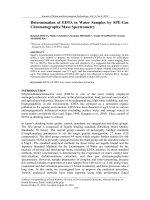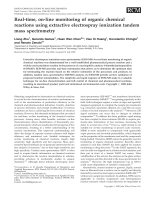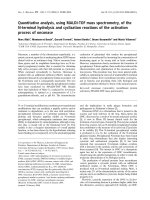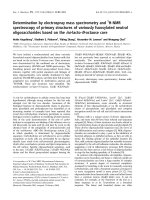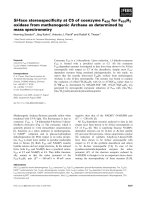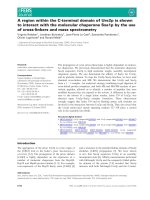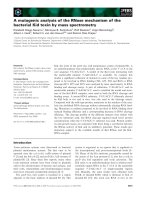Analysis of keto enol tautomers of curcumin by liquid chromatography mass spectrometry
Bạn đang xem bản rút gọn của tài liệu. Xem và tải ngay bản đầy đủ của tài liệu tại đây (402.66 KB, 3 trang )
Original article
Analysis of keto-enol tautomers of curcumin by liquid chromatography/mass
spectrometry
Shin-ichi Kawano
a,b
, Yusuke Inohana
c
, Yuki Hashi
b
, Jin-Ming Lin
a,
*
a
Department of Chemistry, Beijing Key Laboratory of Microanalytical Methods and Instrumentation, Tsinghua University, Beijing 100084, China
b
Shimadzu Global COE for Application & Technical Development, Shimadzu (China) Co., Ltd., Shanghai 200052, China
c
Global Application Development Center, Shimadzu Corporation, Kyoto 604-8511, Japan
1. Introduction
Curcumin (C
21
H
20
O
6
) is a well-known compound found in
turmeric. This yellow pigment has been reported to show various
pharmacological activities. Because of its anti-inflammatory and
anti-cancer effects, curcumin is expected to be a potential drug for
cancer or Alzheimer’s disease [1–5]. Quantitative analysis of
curcumin and its analogues, such as demethoxycurcumin and
bisdemethoxycurcumin, is important for the quality assurance of
turmeric products [6–8] or for monitoring their concentration in
biological fluids [9–11]. High performance liquid chromatography
(HPLC) with UV detection is a useful and popular technique for
those purposes. It is known that curcumin shows prototropic
(keto-enol) tautomerism [2,4,5]. Interest about curcumin’s form in
solution has arisen because there is a strong relationship between
tautomeric structure and effects on biological systems [12,13].In
our study, keto-enol tautomers of curcumin were analyzed by
quadrupole ion trap/time-of-flight mass spectrometry (QIT/
TOFMS). Tautomers of curcumin were separated using an ODS
column with water/acetonitrile as the mobile phase. Hydrogen/
deuterium (H/D) exchange LC/MS technique [14,15] with accurate
mass measurement was applied for confirmation of both
tautomers.
2. Experimental
Standard curcumin solutions (5–500
m
g/mL in water/acetoni-
trile (50/50, v/v)) were prepared. The liquid chromatograph was a
Shimadzu (Kyoto, Japan) Prominence UFLC system with an SPD-
M20A photodiode array (PDA) detector. A Shimadzu Shim-pack
XR-ODS II (30 mm  1.5 mm, 2.2
m
m) analytical column was kept
at 40 8C. Mobile phase was water/acetonitrile (45/55). The flow
rate of the mobile phase was set at 0.2 mL/min. The wavelength of
the PDA detector ranged from 200 nm to 600 nm. Mass spectrom-
etry was conducted using a Shimadzu LCMS-IT-TOF hybrid QIT/
TOF mass spectrometer equipped with an electrospray ionization
(ESI) interface in positive/negative ion mode. The probe voltage for
ESI was set at +4.5 kV for positive detection, or À3.5 kV for negative
detection. MS/MS spectra of curcumin were obtained with the
conditions as follows: precursor ion for positive detection, m/z
369.1333; precursor ion for negative detection, m/z 367.1187. For
H/D exchange experiment, D
2
O (Sigma–Aldrich) was introduced to
the ESI interface with an auxiliary LC pump. The flow rate was set
at 0.8 mL/min. Precursor ion was set at m/z 369.1305 for negative
detection.
3. Results and discussion
On a mass chromatogram at m/z 367.1187 in negative detection
(Fig. 1), a small peak (peak 1) appeared at an earlier retention time
(0.40 min) and a large peak of curcumin (peak 2) was observed at
1.45 min. UV spectra of these peaks were different from each other
Chinese Chemical Letters 24 (2013) 685–687
ARTICLE INFO
Article history:
Received 4 March 2013
Received in revised form 16 April 2013
Accepted 23 April 2013
Available online 5 June 2013
Keywords:
Keto-enol tautomer
Curcumin
Liquid chromatography/mass spectrometry
ABSTRACT
Keto-enol tautomers of curcumin were confirmed by reversed-phase liquid chromatography (RPLC)/
hybrid quadrupole ion trap/time-of-flight mass spectrometry (QIT/TOFMS). Tautomers gave different
MS/MS spectra in negative mode. Different mass spectra were also obtained by hydrogen/deuterium
exchange LC/MS/MS in positive mode. Our results suggest that enol form is the major form in the
solution (water/acetonitrile).
ß 2013 Jin-Ming Lin. Published by Elsevier B.V. on behalf of Chinese Chemical Society. All rights reserved.
* Corresponding author.
E-mail address: (J M. Lin).
Contents lists available at SciVerse ScienceDirect
Chinese Chemical Letters
journal homepage: www.elsevier.com/locate/cclet
1001-8417/$ – see front matter ß 2013 Jin-Ming Lin. Published by Elsevier B.V. on behalf of Chinese Chemical Society. All rights reserved.
/>(
l
max
at 353 nm for peak 1,
l
max
at 429 nm for peak 2). With either
wavelength, peak 1 showed lower absorbance than peak 2 in PDA
chromatograms. To confirm whether peak 1 represents an
impurity of curcumin with a different structure or another form
of curcumin, after fractionation of peak 2, a portion of the fraction
was subjected to analysis again. The chromatogram was similar to
the previous one with a small peak at earlier retention time
(0.40 min) than that of main peak (1.45 min). A computational
approach was tried to determine the stable structure of curcumin
by Kolev et al. [16]. They proposed that the most stable
configuration of the enol form had a planar structure and that
of the keto form had a folded (non-planar) structure at C-4 position
of heptadiene. If peak 1 represents either of the forms, then peak 1
would be the keto form and peak 2 would be the enol form because
of the retentive properties according to the size of molecules onto
the ODS surface. For further identification of the peaks 1 and 2, MS/
MS experiments were conducted. MS/MS spectra of these peaks by
positive detection were very similar each other. As studied by Jiang
et al. [17], ions C
11
H
11
O
2
+
were detected at m/z 175.0764 (error:
2.9 ppm, Fig. 2a) and at m/z 175.0773 (error: 8.0 ppm, Fig. 2c). Ions
C
14
H
13
O
4
+
were detected at m/z 245.0827 (error: 5.3 ppm, Fig. 2a)
and at m/z 245.0799 (error: À6.1 ppm, Fig. 2c). For positive
detection, the ketone moiety would be the position of protonation.
At the earlier stage of fragmentation pathways, both the keto form
and enol form would produce the same ions. MS/MS spectra by
negative detection were different (Fig. 2b and d). Peak 1 gave ions
at m/z 175.0421 ([C
10
H
7
O
3
]
À
, error: 14.8 ppm), m/z 160.0189
([C
9
H
4
O
3
]
À
, error: 18.1 ppm) and peak 2 gave ions at m/z 173.0623
([C
11
H
9
O
2
]
À
, error: 11.5 ppm), m/z 158.0383 ([C
10
H
6
O
2
]
À
, error:
9.5 ppm) in negative detection. For negative detection, these forms
would take different fragmentation pathways reflecting the
difference in structure as a phenolic hydroxyl group would be
deprotonated. Furthermore, H/D exchange technique was applied
[(Fig._1)TD$FIG]
Fig. 1. Mass chromatogram (m/z 367.1187, negative detection).
[(Fig._2)TD$FIG]
Fig. 2. MS/MS spectra of peaks 1 and 2 in positive and negative detections. (a) Peak 1, positive, (b) peak 1, negative, (c) peak 2, positive, and (d) peak 2, negative.
[(Fig._3)TD$FIG]
Fig. 3. Mass spectra of peaks 1 and 2 with H/D exchange MS. (a) Peak 1, positive, MS, (b) peak 1, negative, MS/MS, (c) peak 2, positive, MS, and (d) peak 2, negative, MS/MS.
S. Kawano et al. / Chinese Chemical Letters 24 (2013) 685–687
686
because the number of exchangeable hydrogens of the enol form
and the keto form are different. Two phenolic hydrogens of keto
form, and two phenolic hydrogens and one aliphatic hydroxyl
hydrogen of enol form are exchangeable. Mass spectra of curcumin
tautomers showed apparent differences (Fig. 3). In positive
detection, curcumin gave vast sodium adduct ions while proton-
ated molecules were rarely observed because of high content of
sodium ion in the D
2
O solvent. Although both peaks gave ions at
m/z 393 and 394, the intensity of m/z 394 for peak 2 was doubled
compared with that for peak 1. Ions [C
21
H
18
D
2
O
6
+ Na]
+
(m/z 393.1274, error: À2.3 ppm) as the base peak for peak 1
(Fig. 3a) and ions [C
21
H
17
D
3
O
6
+ Na]
+
(m/z 394.1349, error:
0.8 ppm) as the base peak for peak 2 (Fig. 3c) were observed.
This result shows difference in H/D exchange at aliphatic hydroxyl
group of enol. In negative detection, mass spectra (Fig. 3b and d)
were similar to those without use of deuterium (Fig. 2b and d). This
indicates that major product ions by negative MS/MS do not
contain exchangeable hydrogen. As a consequence, representative
fragmentation positions in negative detection were summarized in
Fig. 4. The results by LC/UV and LC/MS/MS indicate that the major
form of curcumin in water/acetonitrile is enol form.
4. Conclusion
Our experiment with a PDA detector and a QIT/TOF mass
spectrometer supposed that the enol form of curcumin is the major
component in the solution. Two forms were separately confirmed
by LC/MS/MS. H/D exchange LC/MS/MS was informative to confirm
forms of curcumin. The results obtained here have good agreement
with those by spectroscopic [16] and NMR [18] studies.
Acknowledgment
This work was supported by the Research Fund for the Doctoral
Program of Higher Education (No. 20110002110052).
References
[1] B.B. Aggarwal, K.B. Harikumar, Potential therapeutic effects of curcumin, the anti-
inflammatory agent, against neurodegenerative, cardiovascular, pulmonary, met-
abolic, autoimmune and neoplastic diseases, Int. J. Biochem. Cell Biol. 41 (2009)
40–59.
[2] R.A. Sharma, A.J. Gescher, W.P. Steward, Curcumin: the story so far, Eur. J. Cancer
41 (2005) 1955–1968.
[3] S. Bengmark, M.D. Mesa, A. Gil, Plant-derived health: the effect of turmeric and
curcuminoids, Nutr. Hosp. 24 (2009) 273–281.
[4] K. Balasubramanian, Molecular orbital basis for yellow curry spice curcumin’s
prevention of Alzheimer’s disease, J. Agric. Food Chem. 54 (2006) 3512–3520.
[5] H. Hatcher, R. Planalp, J. Cho, F.M. Torti, S.V. Torti, Curcumin: from ancient
medicine to current clinical trials, Cell. Mol. Life Sci. 65 (2008) 1631–1652.
[6] R.F. Tayyem, D.D. Heath, W.K. Al-Delaimy, C.L. Rock, Curcumin content of turmeric
and curry powders, Nutr. Cancer 55 (2006) 126–131.
[7] W. Wichitnithad, N. Jongaroonng amsang, S. Pumman gura, P. Rojsitthis ak, A
simple isocratic HPLC method for the simultaneous determination of curcu-
minoids in commercial turmeric extracts, Phytochem. Anal. 20 (2009)
314–319.
[8] J. Zhang, S. Jinnai, R. Ikeda, M. Wada, S. Hayashida, K. Nakashima, A simple HPLC-
fluorescence method for quantitation of curcuminoids and its application to
turmeric products, Anal. Sci. 25 (2009) 385–388.
[9] A. Liu, H. Lou, L. Zhao, P. Fan, Validated LC/MS/MS assay for cur cumin and
tetrahydrocurcumin in rat plasma and application to pharmacokinetic study
of phospholipid complex of curcumin, J. Pharm. Biomed. Anal. 40 (2006)
720–727.
[10] K. Yang, L. Lin, T. Tseng, S. Wang, T. Tsai, Oral bioavailability of curcumin in rat and
the herbal analysis from Curcuma longa by LC–MS/MS, J. Chromatogr. B 853
(2007) 183–189.
[11] J. Li, Y. Jiang, J. Wen, G. Fan, Y. Wu, C. Zhang, A rapid and simple HPLC method for
the determination of curcumin in rat plasma: assay development, validation and
application to a pharmacokinetic study of curcumin liposome, Biomed. Chroma-
togr. 23 (2009) 1201–1207.
[12] J.R. Fuchs, B. Pandit, D. Bhasin, et al., Structure–activity relationship studies of
curcumin analogues, Bioorg. Med. Chem. Lett. 19 (2009) 2065–2069.
[13] D. Yanagisawa, N. Shirai, T. Amatsubo, et al. , Relationship between the tauto-
meric structures of curcumin deriva tives and their A
b
-binding activities in the
context of the therapies for Alzheimer’s disease, Biomater ials 31 (2010)
4179–4185.
[14] T.J. Novak, R. Helmy, I. Santos, Liquid chromatography–mass spectrometry
using the hydrogen/deuterium exchange reaction as a tool for impurity identi-
fication in pharmaceutical process development, J. Chromatogr. B 825 (2005)
161–168.
[15] D.Q. Liu, L. Wu, M. Sun, P.A. MacGregor, On-line H/D exchange LC–MS strategy for
structural elucidation of pharmaceutical impurities, J. Pharm. Biomed. Anal. 44
(2007) 320–329.
[16] T.M. Kolev, E.A. Velcheva, B.A. Stamboliyska, M. Spiteller, DFT and experimental
studies of the structure and vibrational spectra of curcumin, Int. J. Quantum
Chem. 102 (2005) 1069–1079.
[17] H. Jiang, A
´
. Somogyi, N.E. Jacobsen, B.N. Timmermann, D.R. Gang, Analysis of
curcuminoids by positive and negative electrospray ionization and tandem mass
spectrometry, Rapid Commun. Mass Spectrom. 20 (2006) 1001–1012.
[18] F. Payton, P. Sandusky, W.L. Alworth, NMR study of the solution structure of
curcumin, J. Nat. Prod. 70 (2007) 143–146.
[(Fig._4)TD$FIG]
Fig. 4. Fragmentation of curcumin in keto form and enol form by negative MS/MS.
S. Kawano et al. / Chinese Chemical Letters 24 (2013) 685–687
687
